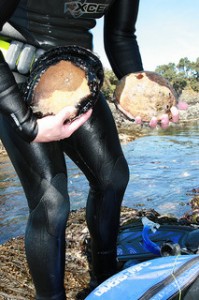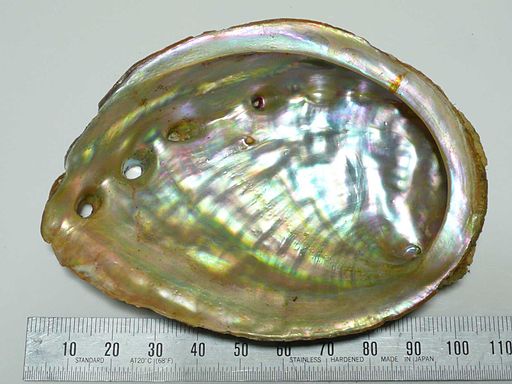
I first wrote about abalone in 2012, and thing are looking even worse than they did at the time. The abalone sport fishery in California has been closed until 2021. Researchers and abalone divers are starting to remove sea urchin, which have taken over the abalone’s habitat and munched away at kelp forests. Hopefully the closures and other efforts will add up to make the abalone a little less lonely, someday.
*
Single White Abalone: female, 7, seeks male. Too bad we’re not hermaphroditic like terrestrial gastropods, or I wouldn’t have to be so picky. Likes: rocky substrate, algae. Looking for a mate who lives within three to five meters. Long-distance just doesn’t work for me.
The white abalone, the first marine invertebrate to make the federal endangered species list, has a problem with distance. In fact, most abalone do. They’re broadcast spawners, sending their gametes out into the sea. If a male and female are farther than five meters apart, it’s like they’re on opposite sides of the ocean—they won’t be able to reproduce.
So when something starts to wipe out their population—overfishing, diseases, predators like sea otters—things can go bad, and quickly.
I’ve always been interested in abalone, I think because I associate them with something forbidden. The first shell I saw—at a neighbor’s house, when I was young—had same sort of subtle rainbow that come from oily puddles in a rainy parking lot. I thought it was beautiful, but also thought it wasn’t a sort of beauty I was supposed to talk about. (The dark appeal of that particular abalone shell might have been because it was an ashtray.)
Later, abalone seemed more appealing—and more unreachable—as species by species, they began to disappear from the California coast. Black, green, red, white, pink abalone. Commercial fishing for all species was shuttered. Recreational divers can hunt for red abalone north of an imaginary line that divides San Francisco Bay.
This week I went to a talk about abalone, but the truth was, I didn’t expect to hear much beyond the story I already knew: California abalone are in trouble. By now I shouldn’t be surprised to find that there are so many things I don’t know, but it seems to happen all the time.
I always thought the California coast was the alpha and omega of abalone. In fact, they’re (almost) everywhere: the Atlantic, the Pacific, French Polynesia, New Zealand. In South Africa, they’re known as perlemoen; to divers on the British Channel Islands, they’re ormers. (In fact, a policeman sporting wetsuit, mask and goggles reportedly made the country’s first underwater arrest in 2005 by catching an ormer poacher in the act.)
Daniel Geiger, the co-author of a new comprehensive guide to abalone worldwide, said part of the reason they caught his interest was because he could travel around the globe to study them. Little is known about their larvae, but it’s likely they can’t travel too far before finding a place to settle and eat coralline algae. Even then, Geiger said, their lifestyle is cryptic. Juveniles hide in crevices and under sea urchins. Finally, when an abalone nears three or four years old, it anchors itself more visibly to the substrate. It can move, but usually doesn’t go far.
As abalone around them disappear, those that remain become increasingly isolated. And apart from in New Zealand, Geiger said, most populations are under siege from a variety of forces.
Earlier this spring I read about a high school’s project to transplant abalone. I was excited that high school kids—no matter where they lived—were doing such a cool project. And that there might be a chance of reviving struggling abalone populations.
But Geiger told me transplanting projects have rarely worked. Divers can hand-plant abalones on the rocks–which means finding a rare spot with no algae or barnacles so that the abalone can get a good grip on the substrate. Or you could grow abalones on rocks in the lab, and then transplant the mini-ecosystem–which sounds lovely, but is likely to be costly and challenging.
“It’s a real bummer,” Geiger said. “The only thing you can do is wait.”
Yesterday I watched Neil Gaiman’s commencement address to graduates of the University of the Arts in Philadelphia. One of the things that struck me was when he talked about the process of so much of his early work as sending a message in a bottle—just putting his ideas out there, never knowing what would be read, what someone might respond to.
Abalone seem different to me now. It no longer appeals because it’s forbidden fruit, but because it’s a creature that’s just out there doing what it can. And this makes them more like me and everyone I know. Beneath the ocean, they’re casting out their free-floating futures with little hope of response. And I do find myself hoping for them–even more than I hope for myself–that they’ll get the answers they need.
***
Images: Top: Christos Vittoratos Middle: Katrina Ramser Bottom: N yotaru

